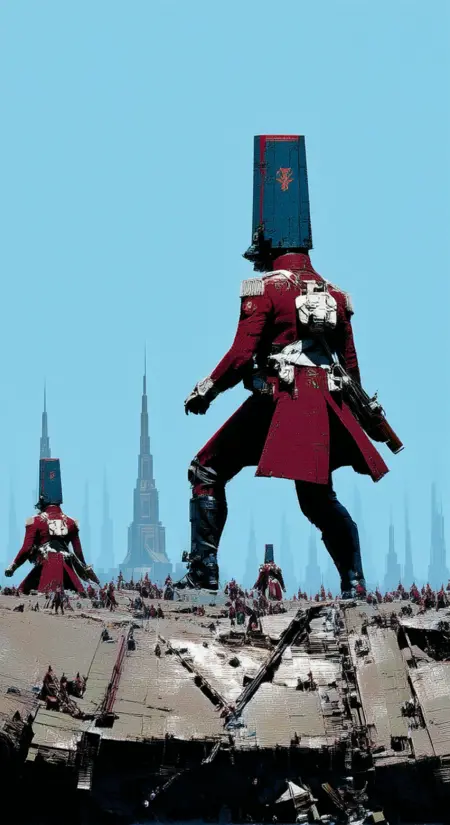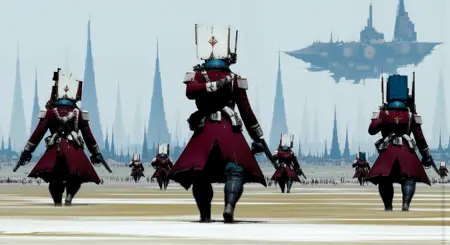DJZ EMPIRE - Soldier
Details
Download Files
Model description
Use with the Style model DJZ EMPIRE
GKG Soldier Image Model Analysis
Executive Summary
This report analyzes a collection of image generation prompts used to train a generative image model focused on a specific visual theme - the "GKG soldier." Based on the caption data, this model appears specialized in generating dystopian military figures in futuristic/post-apocalyptic settings. The prompts follow a consistent pattern, beginning with "illustration of gkg soldier," suggesting this is the primary trigger phrase for the model.
Common Elements and Patterns
Primary Trigger Phrase
- "illustration of gkg soldier" - This appears at the beginning of every prompt and appears to be the main trigger for the model's specific output.
Character Design Elements
Uniform Colors:
Red coats/uniforms (extremely common)
Black accents
Blue elements (less common)
White emblems/symbols/trim
Distinctive Headgear:
Tall hats (frequent)
Helmets with visors
Box-like/rectangular heads
Helmet resembling "computer monitor"
"Top hat" style headgear
Cylindrical head shapes
Weaponry:
Rifles (most common)
"Large, intricate weapons"
Shields
Backpack-like devices
Setting/Environment Elements
Landscapes:
Destroyed/dilapidated cities (extremely common)
Tall buildings/skyscrapers (extremely common)
Industrial structures
Barren/desolate landscapes
Snow-covered ground
Rocky terrain
Urban ruins
Atmospheric Conditions:
Overcast skies
Fog/haze
Smoke/debris in air
Muted color palettes (grays, blues)
Character Positioning/Activities
Formations:
Marching in formation
Standing in alertness
Walking away from viewer (common)
Small groups (2-4 figures)
Single figure with others in background
Visual Style Analysis
The model appears to generate images with a consistent visual aesthetic:
Dominant Art Style:
Dystopian/post-apocalyptic
Militaristic
Science fiction/futuristic
Color Palette:
Red (primary character color)
Black (secondary character color)
Blue (accent color)
White (accent/symbol color)
Muted backgrounds (grays, blues)
Compositional Tendencies:
Characters in foreground, cityscape in background
Figures often facing away from viewer
Multiple figures in formation
Central figure often more detailed/prominent
Scope of Image Model Capability
Based on the prompt analysis, the GKG soldier model appears capable of generating:
Character Variations:
Single soldiers vs. groups
Different weapon types
Various headgear styles
Different poses and formations
Environmental Variations:
Urban destruction vs. barren landscapes
Industrial settings vs. natural desolation
Different weather conditions (snow, fog, clear)
Various building types in backgrounds
Emotional Tones:
Military discipline/order
Post-apocalyptic survival
Desolation/abandonment
Tension/readiness for conflict
Prompt Structure Analysis
The prompts follow a consistent structure:
Begin with "illustration of gkg soldier,"
Followed by period and space
Then a detailed description of the scene
Example structure:
illustration of gkg soldier, . [detailed description of the scene, character appearance, setting, and mood]
This suggests the model expects this specific formatting to properly interpret the prompt.
Distinctive Visual "GKG Soldier" Identifiers
From analyzing the captions, a "GKG soldier" appears to be characterized by:
Red coat/uniform (nearly universal)
Distinctive headgear (oversized, often rectangular or cylindrical)
Futuristic/unusual weapons
Positioning within a destroyed urban landscape
Military formation/posture
Limitations and Boundaries
The model appears limited to:
Dystopian/post-apocalyptic aesthetics
Military/combat themes
A specific character design language (red uniforms, distinctive headgear)
Urban/industrial environments
There are no prompts requesting:
Peaceful/utopian settings
Civilian activities
Natural landscapes without urban destruction
Close-up portraits or character emotions
Conclusion
The "GKG soldier" image model appears to be a specialized generative model focused on creating images of distinctive militaristic figures in dystopian settings. The consistent trigger phrase "illustration of gkg soldier" activates a specific visual style characterized by red-uniformed soldiers with unique headgear against backdrops of urban destruction.
The prompts suggest this model was trained to generate variations within a tightly defined visual concept rather than for general-purpose image generation. The repetitive nature of the prompts, with minor variations in scene details, suggests a training methodology focused on consistency of output within a specific aesthetic range.









